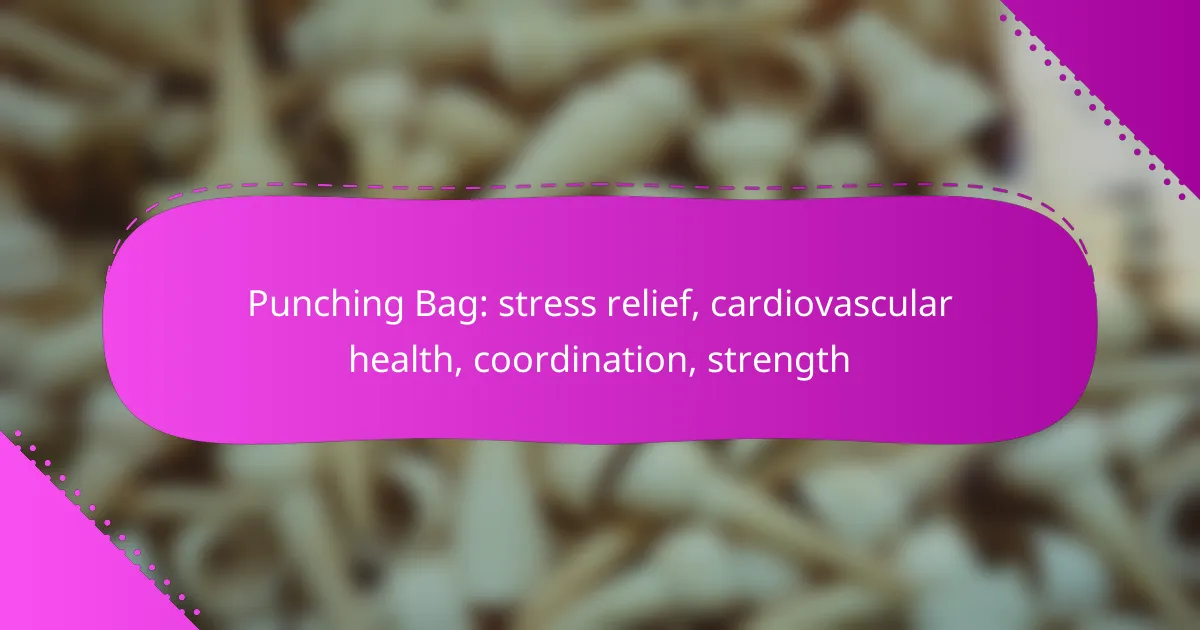A punching bag serves as an excellent tool for stress relief, allowing individuals to channel their emotions and tension into a physical workout. In addition to promoting mental well-being, it offers cardiovascular benefits by boosting heart rate and improving circulation, while also enhancing coordination and strength through the simultaneous movement of hands and feet. Engaging with a punching bag can lead to a healthier body and mind, making it a valuable addition to any fitness routine.

How does a punching bag relieve stress in Australia?
A punching bag can effectively relieve stress by providing a physical outlet for pent-up emotions and tension. Engaging in this activity not only promotes physical fitness but also contributes to mental well-being, making it a popular choice for stress relief across Australia.
Physical activity reduces cortisol levels
Engaging in physical activity, such as hitting a punching bag, can significantly lower cortisol levels, the hormone associated with stress. Regular workouts help the body manage stress more effectively, leading to a calmer state of mind.
In Australia, many fitness experts recommend incorporating at least 150 minutes of moderate exercise per week to maintain optimal cortisol levels. Punching bags can be an excellent way to achieve this, as they provide both cardio and strength training benefits.
Releases endorphins for mood enhancement
Hitting a punching bag triggers the release of endorphins, which are chemicals in the brain that act as natural painkillers and mood elevators. This endorphin rush can lead to feelings of happiness and euphoria, often referred to as the “runner’s high.”
Incorporating punching bag workouts into your routine can be a fun and effective way to boost your mood. Many Australians find that even short sessions of 20-30 minutes can lead to noticeable improvements in their emotional state.
Provides an outlet for frustration
A punching bag serves as a constructive outlet for frustration and anger, allowing individuals to channel their emotions in a healthy way. Instead of resorting to negative behaviors, hitting a bag can provide a sense of relief and accomplishment.
Setting aside time to punch a bag when feeling overwhelmed can help manage emotions more effectively. Many people in Australia find that this practice not only alleviates stress but also enhances focus and clarity in other areas of their lives.

What are the cardiovascular benefits of using a punching bag?
Using a punching bag offers significant cardiovascular benefits by elevating heart rate and improving overall circulation. Engaging in this activity can enhance your aerobic fitness and support effective calorie burning, contributing to better heart health.
Improves heart rate and circulation
Punching a bag increases your heart rate, which is essential for cardiovascular health. As you strike the bag, your body works harder to pump blood, enhancing circulation throughout your system.
Regular sessions can lead to improved heart efficiency, meaning your heart can pump more blood with each beat. This can help lower resting heart rates over time, indicating better heart health.
Enhances aerobic fitness
Training with a punching bag is a dynamic way to boost aerobic fitness. The continuous movement required during workouts elevates your heart rate, promoting endurance and stamina.
To maximize these benefits, aim for sessions lasting at least 20 to 30 minutes, incorporating various techniques like jabs, hooks, and footwork. This variety keeps your heart engaged and helps improve overall fitness levels.
Burns calories effectively
Punching bags can be an effective tool for burning calories, with estimates suggesting that a vigorous session can burn several hundred calories in an hour. The actual number varies based on intensity, duration, and individual factors like weight and metabolism.
To enhance calorie burning, combine punching with other exercises such as footwork drills or strength training. This combination can elevate your heart rate further and increase the overall caloric expenditure during your workout.

How does a punching bag improve coordination?
A punching bag enhances coordination by requiring simultaneous movements of the hands, feet, and body. This practice helps develop the ability to execute precise actions in a fluid manner, which is essential for various physical activities and sports.
Develops hand-eye coordination
Using a punching bag significantly improves hand-eye coordination as you must track the bag’s movement while delivering punches. This dual focus trains your brain to process visual information quickly and translate it into physical action, enhancing your overall reflexes.
To maximize this benefit, practice different punching combinations and vary your distance from the bag. This variability forces your eyes and hands to adapt, further refining your coordination skills.
Enhances footwork and agility
Footwork is crucial when working with a punching bag, as it involves constant movement and positioning. Practicing footwork drills while striking the bag helps develop agility, allowing you to move quickly and effectively in any direction.
Incorporate lateral movements and pivots into your routine to improve your footwork. For example, practice stepping to the side while throwing punches, which can enhance your ability to evade opponents in real-life scenarios.
Promotes rhythm and timing
Working with a punching bag fosters a sense of rhythm and timing, essential components of effective striking. As you punch, you learn to synchronize your movements, which can lead to more powerful and accurate hits.
To enhance your rhythm, consider using music with a steady beat during your workouts. This can help you establish a consistent pace, making it easier to develop timing between your punches and footwork.

What strength gains can be achieved with a punching bag?
Using a punching bag can lead to significant strength gains across various muscle groups, particularly in the upper body, core, and legs. Regular training enhances muscle endurance, power, and overall physical fitness, making it an effective tool for strength development.
Builds upper body strength
Punching bags primarily target the muscles in the arms, shoulders, and chest. As you throw punches, the repetitive motion engages these muscle groups, leading to improved strength and muscle tone. Incorporating different punches, such as jabs, crosses, and hooks, can further diversify your workout and challenge your upper body.
For optimal results, aim for sessions that last between 20 to 30 minutes, focusing on technique and power. Gradually increase the intensity by adding speed or incorporating weights, such as wrist weights, to enhance strength gains.
Increases core stability
Training with a punching bag requires strong core engagement to maintain balance and generate power. The twisting and rotational movements involved in striking the bag activate the abdominal muscles and obliques, leading to improved core stability. A strong core is essential for overall athletic performance and injury prevention.
To maximize core benefits, incorporate footwork and movement around the bag. This dynamic approach not only strengthens the core but also enhances coordination and agility, essential for effective striking.
Develops leg power
Leg strength is crucial for generating power in punches and maintaining balance during workouts. Kicking the bag or using a low stance while punching can significantly enhance leg power and endurance. Exercises like squats and lunges can complement your punching bag routine, targeting the quadriceps, hamstrings, and calves.
Incorporate leg-focused drills, such as side kicks or knee strikes, to engage the lower body effectively. Aim for a balanced routine that includes both upper and lower body exercises to ensure comprehensive strength development.

What should I consider when choosing a punching bag?
When choosing a punching bag, consider factors such as weight, size, material, and mounting options to ensure it meets your fitness goals and fits your available space. Selecting the right bag can enhance your stress relief, cardiovascular health, coordination, and strength training.
Weight and size for user compatibility
The weight and size of a punching bag should match your body weight and training style. A general rule is to select a bag that is about half your body weight; for instance, if you weigh around 70 kg, a bag weighing 30-35 kg would be suitable. Additionally, consider the height of the bag; taller individuals may prefer longer bags for a more natural striking experience.
For beginners, lighter bags (around 10-20 kg) are easier to handle and can help build confidence. As you progress, you may want to transition to heavier bags to increase resistance and challenge your strength.
Material durability and type
The material of a punching bag affects its durability and feel. Common materials include leather, synthetic leather, and vinyl. Leather bags tend to be more durable and provide a better striking experience, while synthetic options are often more affordable and easier to maintain.
Consider the type of training you will do; for example, heavy bags are typically filled with sand or foam, while speed bags are lighter and designed for quick punches. Choose a material that aligns with your training intensity and frequency.
Mounting options for space considerations
Mounting options for punching bags include freestanding, wall-mounted, and ceiling-mounted types. Freestanding bags are ideal for smaller spaces as they can be moved easily and do not require installation. However, they may not provide the same stability as mounted bags.
If you have the space and prefer a more permanent solution, wall or ceiling-mounted bags can be more stable and allow for a wider range of movement. Ensure that your mounting hardware is secure and suitable for the weight of the bag to prevent accidents during use.
